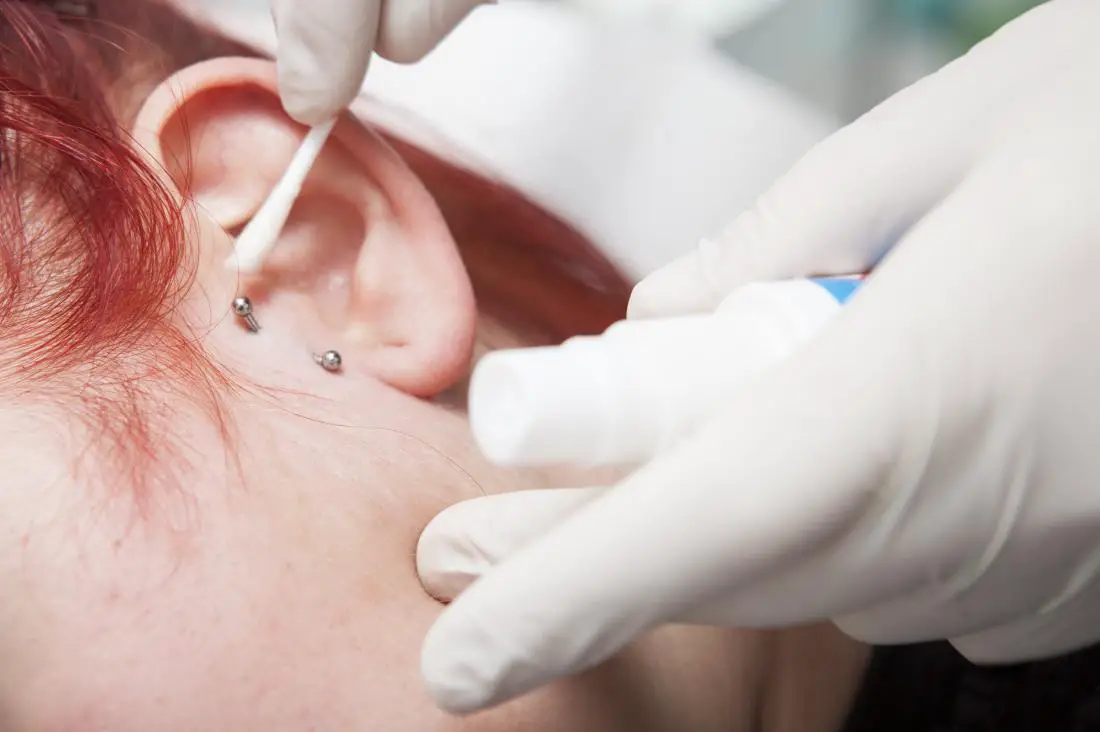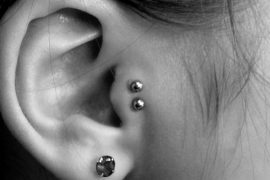Tragus Piercing – Process, Pain, Infection, Cost And Healing Time
What exactly is a tragus piercing?
As you are considering to get your tragus pierced, you must have millions of questions running on your mind right now. From Tragus Jewelry ideas to actual piercing to after care, here you can find everything you want to know about tragus piercing. However, if there is any question that is still needs to be answered, feel free to drop your comments below. We are happy to answer your queries.
Step 1:
To get the tragus or anti tragus piercing, one should lie on her back so the piercer can easily access and work at the piercing site.
Step 2:
Since tragus has thick cartilage, the piercer may need to apply more pressure than all other piercing while making a puncture. In order to avoid the accidental damages to ear, the piercer will place a cork inside the ear canal.
Step 3:
A straight or curved needle will be pushed through the skin (outside to inside). Once the necessary hole is made, the initial jewelry most preferably a barbell will be added to the piercing.
Step 4:
This Jewelry should not be changed until the tragus piercing completely heals.
Does Tragus Piercing Hurt? If So How Much?
When compare to other piercings, tragus piercings has very few nerve endings. That does not mean you wouldn’t feel any pain in tragus piercing. As the needle breaks the skin, there will be a little discomfort like “pain of sharp pinch” or “pain of a cut“. Usually this pain is bearable and last up to few minutes.
However, if you have a thicker cartilage, you might experience some more pain than the people with thinner cartilage.
Quite simply, it hurts a lot. It’s the most painful ear piercing I’ve ever gotten. That’s just my opinion, though. “Tragus piercings hurt no more than any other cartilage piercings,” Castillo says. This was my first-ever cartilage piercing, so I had nothing to compare it to. I figured it hurt as much as it did because it’s one of the thicker parts of the ear. Thompson assures me that’s not the case, though.
“That’s not how pain works,” he says. “Your nervous system doesn’t care if the part is thicker or thinner. It’s actually more pressure than pain, and it can be a little intimidating because you’re piercing into the ear canal, so you can hear everything.” I can attest to that. That sensation lasts all of two seconds at most, though. It may feel like the longest two seconds of your life, but I forgot about the pain minutes later.
If Thompson had to place the pain of a tragus on a pain scale of one through 10, though, he’d place it at a three or four. I’d say it’s about a five, but it’s all relative. Getting my tragus pierced didn’t hurt so much that I didn’t want to get my ears pierced ever again. Thompson went on to do a vertical stack of two studs on my right lobe. They felt like nothing compared to the tragus. He also pierced the lower part of the cartilage on my left ear, and that hurt significantly less than the tragus, too.
Are there any risks?
Of course, there are always risks involved when getting a piercing: however, getting your tragus pierced is a relatively low-risk procedure when done by a professional, says Arash Akhavan, founder of Dermatology and Laser Group in New York City. “That being said, the low blood supply to the area does make it a piercing that has a slightly higher risk for infection and poor scarring,” he adds.
Some of the most common risks are hypertrophic scarring, which is when a bubble or bump forms around the jewelry, and keloids, which are raised scars. Akhavan points out that any ear piercing comes with the possibility of these happening, though. Getting a stud instead of a hoop will help you avoid these issues. Not only do they make for easier healing, but some piercers also prefer them for aesthetic purposes. “I prefer smaller studs on tragus piercings because it’s a nice place to have a subtle sparkle,” Castillo says.
Don’t believe the urban legends about nerves possibly getting hit during a tragus piercing. “I’ll say in over a decade of piercing, I have never ever had anyone have any serious issue with their tragus piercings,” Castillo says. “I think a lot of that stuff was just spread by people who don’t want your ears to look pretty.”
How long does it take for a tragus piercing to heal?
Tragus piercing healing time. Like any other cartilage piercing, the tragus takes about three to six months to heal. That’s just a rough estimate, though. Because we’re in the age of smartphones and many of us listen to music with earphones or headphones regularly, Castillo says special care should be taken. Akhavan even recommends avoiding using earphones for the first at least four to eight weeks, though ideally until the area is completely healed.
And sorry to break this to you, too, but, “for the first two to three weeks, avoid sleeping on your side to prevent friction on the area,” he says. It’s hard, but airplane pillows help. To be safe, give your piercing about a year before taking out or changing out the jewelry. In that time, Thompson recommends leaving it alone. “Be careful with it. Look at it; don’t touch it,” he says. “It’s there to be admired, not to be played with. It’s not a puppy.”
The only time you should get close to the tragus piercing is when cleaning it. Both piercers and Akhavan advise using an unscented soap, like Dr. Bronner’s 18-In-1 Baby Unscented Pure-Castile Soap, and water. After sudsing the soap up in your hands, you should “gently massage soap onto the jewelry,” Thompson explains. “Move the soap around the jewelry, not the jewelry around the soap. Keep the stud or hoop stationary and gently move the suds inside and out and rinse. That’s all you need to do.“
You can also incorporate a saline solution into your cleansing routine. Thompson likes the NeilMed Wound Wash Piercing Aftercare Fine Mist. “Use that two or three times a day for the first few weeks,” he says. I like to think of it as another step in my skin-care routine.
How much will it cost, though?
The price of a tragus piercing depends entirely on the studio you go to as the type of jewelry they use ranges. At 108, for example, the piercing alone will cost you $40, and an additional $120 to $180 will be added on for a stud.
Factors That Influence Tragus Piercing Pain Level
Different people have different level of pain endurance. Apart from the few factors like piercer skills and piercer experience, jewelry choice can influence the pain level one is about to experience.
Piercer skills
Since a skilled piercer can do his / her job in a precise manner, it plays a major in reducing the pain. It will also ensure safety and faster healing.
Piercer Experience
Experienced piercer knows the right way to handle your tragus no matter whether it is thick or thin. She knows to get the job done probably in just a single stroke. So the sharp pain will go off without even you realize it.
Tragus Jewelry Choice
No matter where you get your tragus pierced, your piercer will only recommend the long bar bell jewelry as an initial jewelry. It shouldn’t be taken out until the wound get completely heals. Some people have reported the increased pain after insertion of wrong Jewelry. To avoid these complications, always go with the noble metal or Titanium or hypo allergic Jewelry which will make your healing process smoother and faster.
Once it’s perfectly healed, you can use barbells, bead rings, studs or anything that suits your tragus.
What Can Be Expected After A Tragus Piercing?
Once you get your tragus pierced, you might expect a slight bleeding and a bearable pain for few minutes. The bleeding may be accompanied by Swelling around the pierced area. However, few people reported a Jaw pain soon after piercing. Under normal circumstances, it could even last for 2 to 3 days.
Technically, this jaw pain is a soar triggered by tragus piercing which gives a feel as if the jaw hurts. This pain will worse with your every smile. It should go on its own within few days. If that lasts beyond 3 days then it’s a red flag! Give some attention. Check with your piercer and treat the infection before it gets worse.
Tragus Piercing Aftercare
Tragus piercing cleaning. Tragus piercing has higher rates of infection. But it is possible to avoid the infection with proper care. Sometimes even the extreme care will worsen the infection. Follow your piercing studio’s advice and stick to it thoroughly. With proper care, your tragus piercing would heal without any issues. tragus piercing aftercare.
How to clean tragus piercing
| Do’s | Don’ts |
|---|---|
| Tragus piercing care, Clean the piercing site and the surrounding area twice a day with the saline solution. Use 3 to 4 Qtips or cotton balls to clean the piercing. You can also use sea salt water solution for cleaning. (Mix 1/4 tea spoon of sea salt with 1 cup of water). | Never remove or change the Jewelry by yourself until the piercing heals completely. It may trap infection to other body parts. |
| Wash your hands using antibacterial solution or antiseptic soap before and after cleaning (touching) the piercing site. | Do not use alcohol or any other dehydrating solutions to clean the piercing. |
| Tie your hair up and make sure your hair or any other products does not come in contact with the pierced site. | Never touch the pierced area with your bare hands even if there is any irritation. |
| Change your pillow covers every day until few weeks. | Avoid sleeping on the same side until the piercing heals. |
| Use separate personal belongings like comb, towel etc. | Do not answer the phone call or hold the headset in the pierced ear. Use your other ear to carry out these tasks. |
Signs That Indicate the Tragus Infection
How do i know if my tragus piercing is infected?.
Infected tragus piercing. Consult a dermatologist when you feel any of the following symptoms beyond 3 days.
- Continued bleeding
- soreness around the piercing site
- jaw pain
- yellow or green discharge
- swelling
- foul smell emerging from the pierced area
Do not panic, if you suspect that your piercing is infected.. Stay calm and fix an appointment with dermatologist. Never remove the Jewelry by yourself. It may make your infection even worse.
When to See A Doctor?
Though experiencing the above symptoms are completely normal after piercing, if it continues beyond 3 days and it does not respond well to your home remedies, fix an appointment with a dermatologist immediately. You can also contact your piercing studio. They will help you to get a speedy recovery.
How to prevent a tragus piercing becoming infected
The tragus is a small pointed area of cartilage on the inner side of the external ear. Situated in front of the entrance to the ear, it partly covers the passage to the organs of hearing.
The tragus is a favorite place to get an ear piercing, and while it can look great, this type of piercing can easily become infected if it is not cared for properly.
Tragus is also the name of the hair that grows in the ears.
Fast facts on infected tragus piercings:
- When a person gets a piercing, they essentially have an open wound.
- Infections develop when viruses, bacteria, fungi, or other microbes enter a person’s body.
- Treatment options vary according to the severity of the infection.
Why is it susceptible to infection?

A tragus piercing is particularly to infection while healing.
Any piercing results in an open wound, which can take around 6 to 8 weeks to heal.
However, cartilage piercings, such as the tragus, can take much longer.
Many of the symptoms of infection appear as a result of the body’s natural defense system trying to fight it off.
There are many reasons why an infection might develop:
- Hygiene: Touching the wound with hands or instruments that are not clean and sterile may transfer bacteria to the piercing, which can lead to an infection.
- Lack of oxygen: Earrings that have been put on too tightly and have not left enough room for the wound to breathe can also lead to an infection.
- Over-touching: An infection can develop if an earring is rough, causing a person to touch it constantly, or if a person does not treat the piercing carefully.
- Hair: Hair that hangs down can also make an ear piercing more susceptible to infection as the area is exposed to more bacteria. Long hair can also get caught in the piercing, irritate the wound, prevent it from healing, and increase the risk of infection.
- Healing time: The longer a piercing takes to heal, the more prone it is to infection.
What are the symptoms?

Pain or discomfort, as well as redness, may indicate an infection.
A person who has had their tragus pierced should keep an eye out for the signs and symptoms of an infection so that it can be treated and managed. To identify an infection, a person needs to know what to expect after a tragus piercing.
For around 2 weeks, it is typical to experience:
- throbbing and discomfort around the area
- redness
- heat radiating from the area
- clear or light yellow seepage from the wound
These are all typical symptoms of the body beginning to heal the wound. Although it can sometimes take around 8 weeks for the wound to fully heal, these symptoms should not last more than 2 weeks.
Infection may be present if a person experiences:
- swelling that does not go down after 48 hours
- heat or warmth that does not go away or gets more intense
- inflammation and redness that does not disappear after 2 weeks
- intense pain
- excessive bleeding
- yellow or dark pus seeping from the wound, particularly pus that gives off an unpleasant door
- a bump which can appear either at the front or back of the piercing site
If anyone suspects that they may have an infection, they should talk to a healthcare professional.
What are the treatment options?
Infected tragus piercing treatment. Some infections may require a prescription from a doctor. Common treatment options are:
- oral antibiotics
- topical antibiotics
- topical steroids
Once treated, piercings typically heal fully.
How to avoid an infected tragus
Choose wisely
Make sure that the piercing studio is reputable, licensed and follows good hygiene practices.
Avoid touching the piercing
Only touch your piercing when necessary after thoroughly washing hands with antibacterial soap. Do not remove or change the jewelry until the piercing has fully healed.
Clean the piercing
Clean the piercing regularly using a saline solution. Most piercers will provide information on how to properly clean the piercing after they have done it.
Avoid products that may irritate the wound
Avoiding irritating products and chemicals, such as rubbing alcohol, may help to prevent infection.
Products that may irritate the piercing wound include:
- some ear care solutions
- rubbing alcohol
- hydrogen peroxide
Also, avoid the following ointments, which can create a barrier over the wound site, preventing proper air circulation:
- Hibiclens
- Bacitracin
- Neosporin
Apply a warm compress
A warm compress can be very soothing on a new piercing and can help reduce redness and swelling and encourage the wound to heal faster. A clean towel soaked in warm water can be helpful.
Alternatively, making a warm compress from chamomile tea bags can be very effective.
Use an antibacterial cream
Applying a mild antibacterial cream can help kill off the bacteria that cause infection.
Keep sheets clean
Make sure to change bed sheets regularly. This will reduce the number of bacteria that can come into contact with the ear while sleeping. Try to sleep on the side that is not pierced, so the wound does not press into sheets and pillows.
Do not aggravate the wound site
Keep hair tied back so it cannot get caught in the piercing and be careful when dressing or brushing hair.
Avoid water
Baths, swimming pools, and even long showers can all increase the risk of infection.
Stay healthy
While the wound is healing it is best to avoid drugs, alcohol and smoking all of which can increase the healing time. Paying close attention to personal hygiene and following good hygiene practices will also minimize the risk of infection and help the piercing to heal faster.
Are there any risks?
Most ear piercing infections can be treated if caught early and properly managed. However, if left untreated, it is possible for an infection to become severe and enter the bloodstream. Infections near the head and brain can be particularly dangerous.
Sepsis is a potentially deadly condition that must be treated quickly.
Symptoms of sepsis and septic shock include:
- a high temperature or low body temperature
- chills and shivering
- an unusually fast heartbeat
- breathlessness or very fast breathing
- feeling dizzy or faint
- confusion or disorientation
- diarrhea, nausea, or vomiting
- slurred speech
- extreme muscle pain
- unusually low urine production
- cold, clammy, and pale or mottled skin
- loss of consciousness
If any of the above symptoms occur after having a tragus piercing, seek medical attention immediately.

